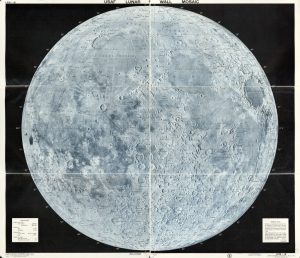The first instance of telescopic based lunar mapping occurred in the 1600’s, illustrating human’s obsession with the moon further. Poems, songs, books, motifs in the later–all of have been centered around the moon. As technology increased, humans began lunar mapping through photographs at the turn of the 20th century. After this advancement, lunar mapping was left to the amateurs as science moved towards mapping other extraterrestrial bodies in our system. This all changed in the 50’s when the possibility of putting humans on the moon became a reality. The effort to map the moon was re- galvanized and astronomers revamped their efforts to get clearer pictures of the moon. The space race–between the USSR and USA during the Cold War–fueled the sudden flurry of effort to be the first world power to put humans on the moon. On Earth, technology can be one upped, but you can only be the first person on the moon once. The US also used the space race as a way to shield the world’s eye away from the issue of the Civil Rights movement that was taking place in the US.
The map itself is very clinical. It leaves out any decorations and any cartouches. Instead it appears to be a map of complete science and therefore complete silence. It was not designed to make a point, but instead was one of the hundreds of maps that carefully mapped the surface of the moon to allow humans to navigate the treacherous landscape of the moon. The audience of the map is not laymen, therefore it seems almost overwhelming in its information. Every minute feature is mapped and it feels confusing to look at. There is so much detail but no information associated. The information that it does provide is drowned out with the silences the map does not answer.
Lunar mapping as a practice became something of an art. There were so many challenges astronomers had to face such as lunar librations and calculating the equator of the moon despite its constant shifting. Finding “sea level” with no water on the moon was difficult due to photos being too low resolution to make any concrete findings. The moon is thousands upon thousands of miles away, yet we know more about it than our oceans. Why? Because the precision with which the moon needed to be mapped in order to safely carry out the Apollo 11 mission was required in its utmost. Not only was mapping the moon a statement of power–a claim that allowed the US to project ownership onto a technically international extraterrestrial body–but coupled with the landing of Apollo 11 a clear statement was made: the US’ power is nearly omnipotent, they can map and send humans to the moon within a few years of study.

